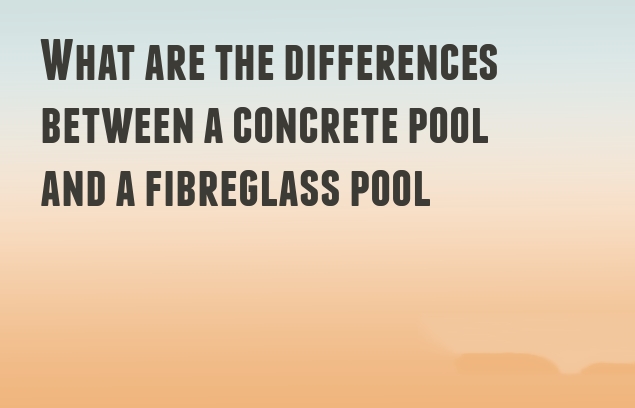
Introduction
Swimming pools have become a necessity and almost everyone fancies a private aquatic retreat. You can host parties, chill by the pool, and even go tanning by the pool. Swimming is also a great exercise and helps you in keeping fit. If you are considering getting a pool for your house you have two main options. Concrete pools or fiberglass pools. These two different pools have their benefits and according to your needs, you can select the best one.
We at swimming pool builders offer both fiberglass and concrete swimming pools and offer services to transport and assemble the pool at your place. To make it easier for you to choose between a fiberglass and a concrete pool we compared these two kinds of pools by taking various factors into consideration and you can go through these comparisons to choose a pool that is best suited for you.
The differences between a concrete pool and a fiberglass pool
Costs (Initial and Lifetime)
Fiberglass pools are pre-manufactured and are then installed into the backyard and sometimes owners do a DIY version of the fiberglass swimming pool and this can cost anywhere around £12,000–£30,000. Building a pool on your own is generally not suggested as there are a lot of risks involved.
If you decide to get the pool manufactured and installed, the expenses can go up to anywhere around $45,000–$85,000 and even more if you fancy a little luxury.
Concrete pools can cost anywhere between £50,000 and £100,000 and these pools take a long time to build. There are several layers of concrete and this is not just any concrete. There is a special mixture of concrete with waterproofing chemicals which helps the pool to handle the water pressure and help in not developing cracks. There are a lot of maintenance costs involved with these pools and the cost of Maintenance can be £25,000 for 10 years.
The cost of building the pool is the same and there is not much difference but the concrete pools are better in the long run.
Customization -
These fiberglass swimming pools come in basic shapes and sizes and the most common measurements for this pool are 16 feet wide, 40 feet long, and 8.5 feet deep. There aren't many opportunities for customization because the fiberglass pools are made from pre-existing molds and all the poos are the same. It will be pretty expensive to get a mold cast for a swimming pool in a design that you like and it would be a huge investment.
The scope of customizing everything around the pool is wider and you can use tanning ledges, poolside waterfalls, etc.
If you want a pool to complement your living space and to fit your needs, going for a concrete pool is the best choice. You can have a pool in whatever shape and size you want and you can even customize the dept of the water at every corner. Customizing the pool way too much can also spoil the essence. You can also decorate and customize everything around the pool just according to your likes.
Fiberglass pools are like a shell and this shell is made by using molds. These shells are created offsite and at the manufacturing unit and they have to transport these hells to the house and attach everything. It takes about 2-3 days for the pool company to ship the shell to your house and it takes an additional 2-3 weeks to attach the drainage system and to assemble everything perfectly.
Installing a concrete pool is a huge mess. The whole backyard is torn open and you see the whole backyard damaged. It takes about 5-6 months to build a concrete swimming pool and this process takes too much time because the backward should be demolished, the base has to be laid, the pool should be set, the cement has to set and everything around it should be worked on again
Interior surface texture
Fiberglass is an advanced formula and the interior is made from a substance called gelcoat. This Gelcoat is very smooth and has various advantages. It gives a clean, polished look to the pool and is very shiny. The biggest advantage of Gelcoat is that it has an anti slip texture and offers grip even underwater.
The interior surface of concrete can have two types of materials, The first material is plaster and this plaster is very rough and can scrape skin very easily. The second type is tiles and covering the total area with tiles can be really expensive.
Durability
Fiberglass is very much durable and the gel coat is also durable. The life of these fiberglass swimming pools is not so much and they tend to get corroded or cracked after 5-6 years. During these 5-7 years, the maintenance cost is minimal and it is also easy to clean the pool.
Concrete swimming pools are very much durable and they have a long life. This is because of the strong concrete infused with other chemicals which extend the life of the pool. The maintenance costs on the other hand are expensive but worth the investment.
Conclusion -
All houses are not the same and having the same type of pool for every single house is also not logical. You have to analyze your requirements and then fix a budget. Then you can go through the factors like the maintenance costs, durability, and life of the pool and select a fiberglass or a concrete pool.